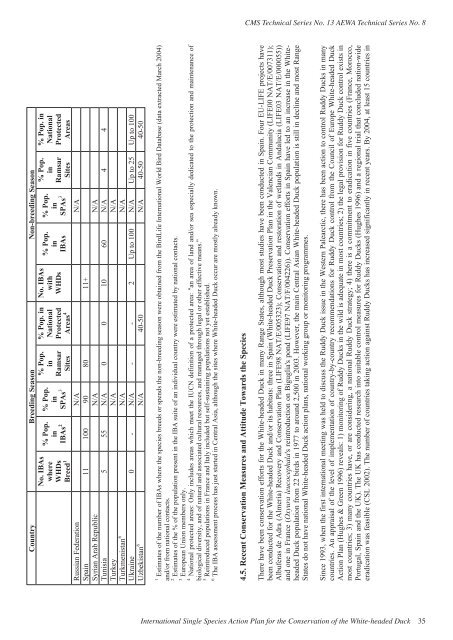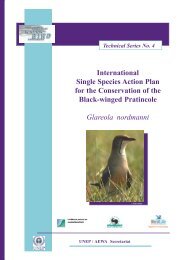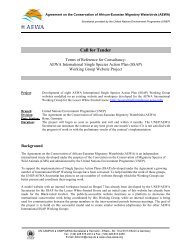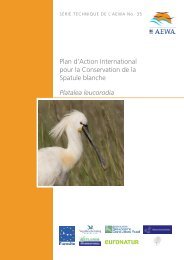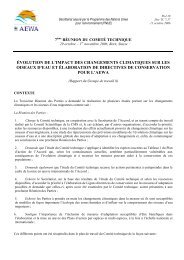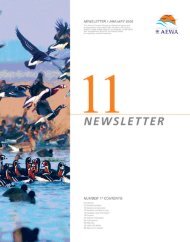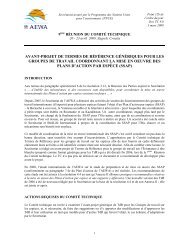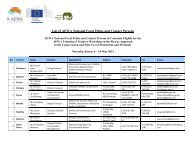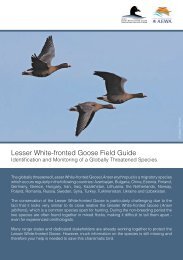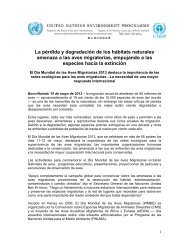International Single Species Action Plan for the Conservation - AEWA
International Single Species Action Plan for the Conservation - AEWA
International Single Species Action Plan for the Conservation - AEWA
Create successful ePaper yourself
Turn your PDF publications into a flip-book with our unique Google optimized e-Paper software.
Country Breeding Season Non-breeding Season<br />
No. IBAs<br />
where<br />
WHDs<br />
Breed 1<br />
% Pop.<br />
in<br />
IBAs 2<br />
% Pop.<br />
in<br />
SPAs 3<br />
% Pop. % Pop. in<br />
in National<br />
Ramsar Protected<br />
Sites Areas 4<br />
No. IBAs<br />
% Pop. % Pop.<br />
with<br />
in in<br />
WHDs<br />
IBAs SPAs 3<br />
% Pop. % Pop. in<br />
in National<br />
Ramsar Protected<br />
Sites Areas<br />
Russian Federation N/A N/A<br />
Spain 11 100 90 80 11+<br />
Syrian Arab Republic N/A N/A<br />
Tunisia 5 55 N/A 0 0 10 60 N/A 4 4<br />
Turkey N/A N/A<br />
Turkmenistan 6<br />
N/A N/A<br />
Ukraine 0 - N/A - - 2 Up to 100 N/A Up to 25 Up to 100<br />
Uzbekistan 6 N/A 40-50 N/A 40-50 40-50<br />
1<br />
Estimates of <strong>the</strong> number of IBAs where <strong>the</strong> species breeds or spends <strong>the</strong> non-breeding season were obtained from <strong>the</strong> BirdLife <strong>International</strong> World Bird Database (data extracted March 2004)<br />
and/or from national contacts.<br />
2<br />
Estimates of <strong>the</strong> % of <strong>the</strong> population present in <strong>the</strong> IBA suite of an individual country were estimated by national contacts.<br />
3<br />
European Union members only.<br />
4<br />
National protected areas: Only includes areas which meet <strong>the</strong> IUCN definition of a protected area: "an area of land and/or sea especially dedicated to <strong>the</strong> protection and maintenance of<br />
biological diversity, and of natural and associated cultural resources, and managed through legal or o<strong>the</strong>r effective means."<br />
5<br />
Reintroduced populations in France and Italy included but self-sustaining populations not yet established.<br />
6<br />
The IBA assessment process has just started in Central Asia, although <strong>the</strong> sites where White-headed Duck occur are mostly already known.<br />
4.5. Recent <strong>Conservation</strong> Measures and Attitude Towards <strong>the</strong> <strong>Species</strong><br />
CMS Technical Series No. 13 <strong>AEWA</strong> Technical Series No. 8<br />
There have been conservation ef<strong>for</strong>ts <strong>for</strong> <strong>the</strong> White-headed Duck in many Range States, although most studies have been conducted in Spain. Four EU-LIFE projects have<br />
been conducted <strong>for</strong> <strong>the</strong> White-headed Duck and/or its habitats: three in Spain (White-headed Duck Preservation <strong>Plan</strong> in <strong>the</strong> Valencian Community (LIFE00 NAT/E/007311);<br />
Albuferas de Adra (Almería) Recovery and <strong>Conservation</strong> <strong>Plan</strong> (LIFE98 NAT/E/005323); <strong>Conservation</strong> and restoration of wetlands in Andalucia (LIFE03 NAT/E/000055))<br />
and one in France (Oxyura leucocephala's reintroduction on Biguglia's pond (LIFE97 NAT/F/004226)). <strong>Conservation</strong> ef<strong>for</strong>ts in Spain have led to an increase in <strong>the</strong> Whiteheaded<br />
Duck population from 22 birds in 1977 to around 2,500 in 2003. However, <strong>the</strong> main Central Asian White-headed Duck population is still in decline and most Range<br />
States do not have national White-headed Duck action plans, national working group or monitoring programmes.<br />
Since 1993, when <strong>the</strong> first international meeting was held to discuss <strong>the</strong> Ruddy Duck issue in <strong>the</strong> Western Palearctic, <strong>the</strong>re has been action to control Ruddy Ducks in many<br />
countries. An appraisal of <strong>the</strong> level of implementation of country-by-country recommendations <strong>for</strong> Ruddy Duck control from <strong>the</strong> Council of Europe White-headed Duck<br />
<strong>Action</strong> <strong>Plan</strong> (Hughes & Green 1996) reveals: 1) monitoring of Ruddy Ducks in <strong>the</strong> wild is adequate in most countries; 2) <strong>the</strong> legal provision <strong>for</strong> Ruddy Duck control exists in<br />
most countries; 3) many countries have, or are considering, a national Ruddy Duck strategy; 4) <strong>the</strong>re is a commitment to eradication in five countries (France, Morocco,<br />
Portugal, Spain and <strong>the</strong> UK). The UK has conducted research into suitable control measures <strong>for</strong> Ruddy Ducks (Hughes 1996) and a regional trial that concluded nation-wide<br />
eradication was feasible (CSL 2002). The number of countries taking action against Ruddy Ducks has increased significantly in recent years. By 2004, at least 15 countries in<br />
<strong>International</strong> <strong>Single</strong> <strong>Species</strong> <strong>Action</strong> <strong>Plan</strong> <strong>for</strong> <strong>the</strong> <strong>Conservation</strong> of <strong>the</strong> White-headed Duck 35


